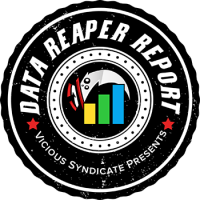
Welcome to the 59th edition of the Data Reaper Report! This is the first report for Knights of the Frozen Throne.
Our Data Reaper Project, including the Data Reaper Live (Beta) has 4,100 active contributors. Without them, this project would not be possible, so we’d like to thank all of our contributors for their help.
Quick Links
Class/Archetype Distribution | Class Frequency | Matchup Winrates | vS Power Rankings | Class Analysis & Decklists | Meta Breaker of the Week | How to Contribute | Credits
Number of Games
|
Overall |
190,000 |
|
Legend |
15,000 |
|
Ranks 1-5 |
70,000 |
|
Ranks 6-10 |
50,000 |
|
Ranks 11-15 |
35,000 |
Class/Archetype Distribution
Class Frequency by Day
Class Frequency by Week
Class Frequency Discussion
My Greetings. The Druid class has surged in its popularity and continues to rise in its frequency every day. Its numbers at legend are nearing 40%, on the back of multiple archetypes establishing a significant presence in the meta. Jade Druid is the most popular deck in the game, nearing 20% at legend and it’s safe to say that its numbers at the top of the legend ladder are significantly higher. Aggro-Token Druid has carved out its place in the meta, and it is the second most popular deck at legend. Mid-Token Druid also has a fair bit of presence, while Ramp Druid maintains a much more modest representation in comparison. At least when it comes to play-rates, we are firmly in the era of Druidstone. Hmm… Well Played.
Priest is the second most popular class in the game, and we’re struggling to remember if that ever happened in the history of Hearthstone. Razakus Priest, the current standard format Highlander deck, is the most popular Priest archetype. Raza and Kazakus have a new friend in Shadowreaper Anduin, a card that has sparked much interest and experimentation. Big Priest has established a presence in the current meta, relying on abusing the interaction between Barnes, Shadow Essence and Eternal Servitude. We are also seeing a very small population of Dragon Priests. Do note that Priest is more popular at lower levels of play and its numbers decline as you climb the ranks.
For the rest of the classes, there’s a different pattern. Diversity is gone. Every class has one main deck, two at most, and that’s pretty much it. Whether this is a result of the meta being fairly young, or of a difficulty in establishing new archetypes in the current meta, is an open question, which we might be able to answer later.
Paladin and Warrior are next in line, and both classes are relying on their aggressive, tribal archetypes to have their place in the meta. Murloc Paladin and Pirate Warrior are both quite prevalent at all levels of play. Other archetypes of these classes are not seeing much of the spotlight. Taunt Warrior has almost completely died out, Control Paladin has a very small presence, and we’re seeing fractures of decks that are highly experimental.
Mage has two archetypes that are seeing a decent amount of play. Exodia Mage has been hyped up a lot, and has become the most popular Mage archetype so far with Secret Tempo Mage right behind it. There are also varied experimentations with tribal Elemental Mage builds looking to fully capitalize on Frost Lich Jaina. As for Control Mage decks, the descendants of Freeze/Burn Mages, they are currently seeing very little play.
Rogue and Shaman are in somewhat similar spots, with one main difference. Both classes have one deck with a significant amount of presence: Miracle Rogue and Token Shaman. However, Rogue has multiple small archetypes that are seeing experimentations, which is quite normal at this point in an expansion’s life. However, we don’t see that at all with Shaman. There is Token Shaman and literally nothing else but crumbs. We don’t believe we’ve ever run into a class that exhibits as little diversity as Shaman is currently exhibiting.
Let’s talk a little about the dead classes of Un’Goro: Warlock and Hunter. While Warlock is actually seeing a lot of play at lower levels, and is the 3rd most popular class between ranks 15 and 11, its representation takes a sharp nosedive on the way to legend, where it sits at the bottom two with Hunter. Both classes are trending down in popularity, and are losing ground quite quickly. Control Warlock and Midrange Hunter are the main archetypes for the classes, with a little bit of Zoo and a little bit of Secret Hunter also present.

vS Power Rankings Discussion
Brace yourselves, Hearthstone players. Winter is here. The Un’Goro golden age has ended. The days of 18 viable archetypes from 8 different classes boasting win rates of over 48%, are gone. The period when decks could hardly break the 52% win rate mark at legend, is over. This is the age of the oppressive few. This is the age of Jade Druid, and the aggro decks that don’t roll over and die at the sight of it. There are only 4 archetypes that currently boast a positive win rate at legend, and there is a huge gap in the power level of these archetypes compared to everything else.
Yes, you could argue the meta is highly experimental, and there are a lot of bad decks being played giving away free wins to the top decks, and over time, their win rates will drop. If they start facing each other more often, the top decks’ win rates will definitely go down through the self-correction of the meta, but that doesn’t mean things are going to get better for everyone else. It doesn’t mean we’re going to see more diversity than we’re seeing now. These results are very alarming.
Jade Druid is the center of the current meta’s attention and might end up being one of the most oppressive decks in the history of Hearthstone. Not because it has the highest win rate, but because it lays waste to more archetypes than we can count, deeming them unplayable. Control decks just cannot live in a meta with Jade Druid at its current power level. The Caverns Below was changed for committing the same crime, but Jade Druid of KFT commits this crime on a much wider scale and does it much more successfully. Crystal Rogue had a win rate hovering around the 50% mark; Jade Druid shapes an entire meta around it while boasting 55%. There is only one deck in the game that boasts a positive win rate against it at legend, and that is Aggro-Token Druid. Murloc Paladin does not counter Jade Druid, as the matchup has slowly gone from being in favor of the Paladin to an even matchup at legend over the course of a week. Miracle Rogue no longer counters Jade Druid, a historical advantage that Rogue lived by and holds no longer. Exodia Mage does not reliably counter Jade Druid, despite all the hype surrounding it. Razakus certainly does not counter Jade Druid. This is a deck that, at the moment, looks nearly unstoppable and is only getting better as it shifts its attention towards beating its biggest meta rivals.
And what other deck looks nearly unstoppable? It’s another Druid deck. Aggro-Token Druid’s power level has spiked significantly this expansion. Druid of the Swarm and Crypt Lord are extremely powerful cards, and have made the Druid’s board much more difficult to remove in the early game. In addition, Jade Druid is suppressing Aggro-Token’s biggest counters, which are defensive decks packing strong forms of AOE and stalling, such as Freeze Mage. Things look really good going forward for Aggro-Token Druid as well, since the two other powerful decks of the current meta are the tribal aggressive decks: Murloc Paladin and Pirate Warrior. We’re already seeing adjustments being made in the archetype’s builds at legend ranks, with Hungry Crabs and Golakka Crawlers making their return and these matchups becoming more favorable for the Druid every day. So, while Murloc Paladin and Pirate Warrior are very powerful, the current trend gravitates towards a reduction in their power levels (we’re already seeing that with Murloc Paladin’s score dropping at legend). For that reason, as well as its decent matchup against Jade Druid, Aggro-Token Druid looks like the best deck in the current meta.
There are three other decks currently boasting decent win rates but all of them have flaws that may hold them back from becoming more popular, unless they make successful adjustments. We’re talking about Token Shaman, Secret Mage and Mid-Token Druid. Token Shaman is probably the most promising one, since it has decent inherent tools to combat aggression. However, its advantage against the two main Druid archetypes seems to have faded away with the new set. Druid’s power level has increased while Shaman mostly sat still. Secret Mage’s issue is that it loses to the top three aggressive decks while struggling to reliably beat Jade Druid, something it excelled at during Un’Goro. Mid-Token Druid is certainly a strong deck, but it might suffer from redundancy. It’s hard to justify playing it over the other two Druid archetypes.
There’s a lot of hype surrounding Razakus, but every metric we currently hold indicates that the archetype is not performing very well. There are several reasons for this. The archetype is currently quite diverse with strategies and builds, so it’s certainly young in its development. It is still being refined, so it’s reasonable to assume that it will get better over time. In the Priest section, we’re also directing you towards the builds that are currently most successful. However, even considering its refinement stage, it’s very unlikely that Razakus Priest will be able to become a top tier, consistently-performing deck due to some significant flaws it bears. Contrary to some people’s experiences, it is not a good deck against Jade Druid and this does not improve whatsoever at higher levels of play. It is also very dependent on tech choices in order to fare better in some matchups, which means it will likely have to adjust to the meta constantly or fall behind. This makes the deck situational, which is not bad compared to other archetypes in this table, but it’s not an inherently strong deck against the field. You have to pick your spots, unlike the Big 4, which play the game as if on a lowered difficulty setting.
Big Priest is actually performing better than Razakus, and this is true at all levels of play. This may come as a surprise, but it’s a deceptively consistent deck. Its biggest nightmare is Pirate Warrior, but it actually performs quite alright against the Druid class. It’s not a crazy strong archetype, but in this meta, everything seems weak compared to the Big 4. We like the archetype’s potential quite a bit and think it has room to grow.
Miracle Rogue is crumbling under the pressure of Druids. Jade Druids are packing Spellbreaker and Big Game Hunter to kill their Edwins and Arcane Giants while running Ultimate Infestation, which is basically a good turn of Auctioneer in one card. Pirate Warriors are smashing their faces with Arcanite Reapers. Token Druids are flooding the board with minions out of the reach of Rogue’s removals. Even Priest isn’t scared of Rogues anymore. This is a dark time for Valeera.
And here’s the really depressing part. Nearly everything else really sucks. There is, of course, always a chance for breakout builds to come out of the poorly performing archetypes and change things. We’re not ruling that out, it would be foolish to do so this early in the expansion. But, as of now the situation is grim and we need some innovations to start popping up because in the early days of Un’Goro, we identified them pretty easily (Secret and Freeze Mage, Murloc Paladin, Silence Priest, Token Shaman). Hunter looks pretty bad, even when it’s quite unrefined. Warlock looks very, very bad. The Handlock variants are better than strictly Demon ones, but that’s not enough to make them competitive. There is a greater chance of Zoo making it somehow. Exodia Mage presses the concede button when you play a 1-drop and proceed to emote. Taunt Warrior’s got no one to hide behind anymore. Control Paladin is losing faith in the light. Control Warrior is still waiting for Fibonacci to do something. Tempo Warrior wishes it were Pirate Warrior. Freeze Mage is on vacation. Control Mage decks are failing. It almost seems like the sky is falling.
And if we were really pressed to say something about hidden gems with low sample sizes while clutching at some straws. If we could mention decks that are not amazing, but could be playable, we have a few. Elemental Rogue should see more exploration because it’s performing quite alright. Handbuff Paladin is showing promise of being a moderately decent deck. Aggro Paladins also have potential, but they are outclassed by Murloc builds. Face or Secret Hunters might be stronger than Midrange Hunters. That’s what we have.
Class Analysis & Decklists
Druid | Hunter | Mage | Paladin | Priest | Rogue | Shaman | Warlock | Warrior
Knights of the Frozen Throne has established Druid as the most prevalent, and perhaps, the most powerful class in the game. Jade Druid has shot up in its win rate to a position of a dominant deck. Spreading Plague and Ultimate Infestation are both cards with insane power levels and can decide games by themselves. Aggro Token Druid is also very strong and has received a couple of powerful tools to complement its board flooding strategy. Mid Token Druid is a new deck that has emerged with decent success, while Ramp EZ BIG Druid is still around with a modest representation.
Jade Druid is terrorizing the field, with an absurdly high play rate and a very strong performance level against the field. Skulking Geist was thought by many to potentially be an effective answer to Jade Druid, but it has done little to stem the tide of Jades. Control Warrior or Control Paladin would be decks that could effectively run the card, and possibly have enough removal for the rest of the Jade Golems, but neither of these decks are popular at the moment.
With the inclusion of Ultimate Infestation as its main draw engine, Auctioneer got taken out of the deck. Several new ways of gaining armor and effective HP, along with Burn/Freeze Mage’s disappearance, has led cutting of dedicated forms of armor gain, such as Feral Rage and Earthern Scales. This has opened space for additional tech cards to be included in order to offset Jade Druid’s primary weaknesses.
Jade Druid’s weaknesses have traditionally been dealing with board flood (Token Shaman/Druid, Murloc Paladin) or a single big threat (Silence Priest, Edwin/Arcane Giant/Adventurer). Spreading Plague is an amazing card to deal with early flooding, and combines well with Druid’s limited AOE to halt wide boards. Machamp’s #1 legend list focuses even more on dealing with wide boards by running Mind Control Techs as well.
Zalae’s #1 legend list techs in Big Game Hunter, Black Knight, and Spellbreaker to deal with the big threats for which Druids lack an answer in their class toolkit. Both lists run Kun, the Forgotten King, which is an extremely versatile card that offers armor gain, but more importantly, an incredible tempo swing when combined with Ultimate Infestation, or when used as a follow up should you draw it after playing UI.
Mid-Token Druid has emerged with new tools to help it snowball seemingly harmless boards into huge minions. Druid of the Swarm and Crypt Lord are extremely hard to remove in the early game, and Strongshell Scavenger can spell doom for the opponent. While the deck can’t end the game as quickly as the Aggressive Token Druid, it has better comeback mechanisms and possesses significant late game longevity, since it runs Ultimate Infestations, Malfurion the Pestilent as well as Spreading Plague. The boards it is able to create are also much more resilient to AOE. Asmodai’s build runs Violet Teacher as an extra token engine that synergizes very well with Power of the Wild and Mark of the Lotus. Feno’s build is heavier in the late game, taking advantage of Medivh’s synergy with Ultimate Infestation.
Aggro Token Druid is in an excellent position in the meta since it is able to get on the board faster than any other deck in the game. The archetype still runs a plethora of small minions along with the board buff package of Mark of the Lotus, Power of the Wild, and Savage Roar. The two significant additions to the deck are Druid of the Swarm and Crypt Lord, which replaced Tar Creeper. Both early game taunts are great for protecting low health minions from weapons and minion trading, and since they are so hard to kill on the turn they are dropped, they are often buffed into an oppressive state. Standard lists often run Dire Wolf Alpha and Crazed Alchemist in order to further complement their strengths. With Pirate Warrior and Murloc Paladin becoming increasingly popular, however, the tribal crab tech is beginning to make a comeback. Esteban hit #1 legend with the help of the famous quad crab package of the Un’Goro days.
Ramp, or “Big” Druid, is also a player in the current meta and another benefactor of Ultimate infestation, though the archetype is much less figured out than the previous three. Standard builds are very similar to lists in Un’Goro, although Paradox hit #7 legend with a list that runs Medivh and drops the Curator/Anaconda package.
- Druid Class Radar
- Zalae’s Jade Druid
- Machamp’s MC Tech Jade Druid
- Esteban’s Crab Aggro-Token Druid
- Standard Aggro-Token Druid
- Feno’s Medivh Mid-Token Druid
- Asmodai’s Violet Mid-Token Druid
- Paradox’ Ramp EZ BIG EZ Druid
- Standard Ramp EZ BIG EZ Druid
Priest is in unfamiliar territory, which is being the second most popular class in the game. The Highlander Priest variant, built upon the foundations of Kazakus and Raza the Unchained, has received an important win condition in Shadowreaper Anduin, allowing the deck to burn down the opponent’s resources as well as its life total fairly quickly. Razakus Priest has been quite shaky in terms of its performance against the field due to a plethora of builds and strategies being tested and refined. The most successful variant, which may elevate the deck to a higher power level, involves heavy cycle. The Raza/Shadowreaper combo is so strong that the optimal strategy appears to be drawing them as quickly as possible rather than relying on alternative, value oriented win conditions. This pushes the deck towards a lean build that runs as much card draw as possible. Another significant late game card is Velen, which gives the deck a burst finisher and is incredibly strong when combined with the hero power as well. RDU has been hovering at the top legend ranks, peaking top 10, with his cycle heavy build, while Honbee hit #11 with a similar list that techs against Pirate Warrior, a pretty bad matchup for the deck.
The other significantly popular Priest archetype, which actually performs better at the moment than the Highlander Razakus one, is the Big EZ Priest. The deck has the potential to win the game on the spot with Barnes on turn 4, followed up by Eternal Servitude. While this is obviously the absolute best case scenario, the deck does have some powerful reactive tools that can help it survive the early to mid-game should it not draw “the nuts”, making it more consistent than it appears to be. Even so, the deck mostly shines in control matchups, where it’s allowed breathing room in the early game to do as it pleases, which involves either Barnes or Shadow Essence.
Dragon Priest still exists as well, and historically at least, it has had a good matchup against Jade Druid. TicTac took note of this and took his Dragon Variant to top 100 legend. Bonemare, the tempo card of the expansion, appears in both TicTac and Ike’s top 100 builds, as landing its buff on any of your dragons on turn 7 pretty much means game over for your opponent. Cobalt Scalebane is also a nice addition to dragon decks, and is quite threatening if left standing for more than one turn. Finally, the Divine Spirit/Inner Fire combo is a strong package against Druids, has innate synergy with Twilight Drake, and offers a way to end games quickly.
- Priest Class Radar
- RDU’s Razakus Priest
- Honbee’s Razakus Priest
- Standard Big Priest
- Frescha’s Big Priest
- TicTac’s Dragon Priest
- Ike’s Dragon Priest
While everyone is up in arms about Druid, Paladin is doing just fine for itself. The most impactful KFT Paladin card so far seems to be Righteous Protector, as regardless of synergy, it is so strong that it is now ubiquitous in all but the most dedicated control lists.
The most prevalent and successful Paladin archetype, by far, is Murloc Paladin, as it is a refined deck from the Un’Goro meta that invited a few new friends. This deck is very dominant against control and other midrange archetypes, and its only weakness appears to be the board flooding aggressive decks that carry strong answers to its tribal synergy, Aggro-Token Druid and Token Shaman. Even against those decks, the matchups aren’t unwinnable and only slightly unfavored at the moment (note that this could change should Hungry Crabs become a more common inclusion in Druid lists while Shamans are re-equipping their second copies of Devolve).
There are three common builds at the moment that vary very slightly. Mitsuhide’s list runs Corpsetaker as a proactive 4-drop as well as Bol’var at the 5 slot, bolstering a mid-game that is otherwise lacking unless you’re ahead on the board with Gentle Megasaur or Blessing of Kings. Ender’s build, which has also been very successful for multiple players at top legend ranks, runs Grimscale Chums to add further consistency to the deck’s early game and offers another target to Rockpool Hunter. Findan’s build, with which he hit #1 legend, drops Corpsetakers for Consecrations, a comeback tool for when you fall behind on the board, especially in your worst matchups against the aforementioned Druids and Shamans.
Control Paladin maintains a small representation, but its early iterations are failing miserably against the current meta. One notable success story is Takuchan’s top 100 legend OTK Control Paladin deck, which runs Auctionmaster Beardo along with Burgly Bullies and Uther of the Ebon Blade. Rather than trying to deal with growing Jade Golems by removing each and every one while utilizing Skulking Geist to limit their amount, it carries a win condition that just ends the game before things get out of hand with the aid of the four horsemen.
Handbuff Paladin is also being experimented with, and might be a legitimately good deck rather than just a meme, with Kibler’s list carrying a strong argument. Prince Keleseth replaces Grimestreet Outfitter as the two drop of choice, and is your #1 priority in the mulligan phase. Corpsetaker and Chillblade Champion have great synergy with the mechanic, while the rest of the deck is filled with “just good cards” that do not rely on the mechanic itself to be strong.
- Paladin Class Radar
- Mitsuhide’s Murloc Paladin
- Ender’s Chum Murloc Paladin
- Findan’s Cons Murloc Paladin
- Takuchan’s Control Paladin
- Kibler’s Handbuff Paladin
Blessed with an incredibly solid core of cards that will be around until April it was always going to be very unlikely that Warrior would fall to the sidelines as long as Pirate Warrior was around.
Pirate Warrior indeed continues to be a powerhouse at the start of Frozen Throne. However, it seems unlikely that this will continue as its win rate is largely propped up by poor meta choices. Pirate Warrior is extremely good at punishing some of the decks that are being overplayed, such as Control Warlock and in particular Exodia Mage. Meanwhile, the top meta decks pose a much more difficult challenge for Pirate Warrior, and are likely to grow in popularity over time. If the meta adjusts to favor the better-performing decks, it is likely that Pirate Warrior’s win rate against the field will decrease. However, Pirate Warrior still has all the hallmarks of a top deck, as it doesn’t have a hard counter that could jeopardize its position in the meta, so it should remain in the leading pack.
Not much has changed as far as decklists are concerned, with the build originally piloted by PNC establishing itself as the standard and Phantom Freebooter being the only new addition from KFT. Spellbreaker has become absolutely mandatory due to the unprecedented number of taunts in the current meta, with some players opting to even run two copies instead of Phantom Freebooter. Bittertide Hydra has established itself as a staple due to its effectiveness against Jade Druid, with Captain Greenskin also becoming popular due to its ability to increase the deck’s reach while also helping it fight for the board. To make way for these 5-drops, many are choosing to cut Leeroy Jenkins, a card that only offers burst and is not useful in many situations. Mortal Strike is also not as popular as it used to be for a similar reason, though its ability to bypass taunts makes it a more common choice for some players.
Warriors’ other options don’t look as promising in comparison. Tempo Warrior has had moderate amounts of success, with Blood Razor and Bonemare being helpful additions to the deck. Bonemare’s incredible value and ability to heavily snowball the board in a deck which is normally able to get a minion to stick on turn 6, makes it an excellent addition. Lektron’s list, piloted by Theo to top 50 legend, looks to be the most successful.
There have been several other Warrior archetypes discussed and theorized but which have yet to see any significant success. Blood Warrior utilizes Dead Man’s hand to stack up insane late game value with Arcane Giants. Meanwhile, Control Warriors have been experimenting with different win conditions (N’Zoth, C’Thun and even fatigue) but they’ve mostly had a miserable time on ladder. Time will tell whether Warrior can be more than a one trick Pirate pony.
KFT has not been kind to Mages. The class is still present at all levels of play but it has fallen considerably in popularity. The most popular archetype currently is Exodia Mage. We have repeatedly said that the Mage quest could flourish in a slower meta and while that was the case in the very first couple of days of the expansion, things have taken a very sharp turn towards aggression since then. The deck is certainly stronger than it used to be, Ghastly Conjurer offers a cheap and defensive way to speed up quest completion while still fighting for board and protecting the Mage’s valuable life total. Another possible addition is Simulacrum which provides redundancy with Molten Reflection when it comes to copying Apprentices, and can act as a substitute if either of the Apprentices is hit by a Dirty Rat, a card that notoriously counters the deck. Neirea’s build is fairly standard and runs Simulacrum as well as two Cabalist’s Tomes, putting a focus on redundancy and reducing the chances you will have to draw your whole deck in order to complete the quest. GinjaNinja’s build is a good example of a list that includes Ghastly Conjurers for the utility we’ve mentioned.
A continuation from the previous meta, Secret Mage remains viable if not legitimately strong. The archetype has yet to be fully refined, with many viable routes available. Apxvoid’s build is fairly standard and takes advantage of Mana Bind, Ghastly Conjurer and Burgly Bully’s synergy with Antonidas. Another interesting build comes from Harutoi, which drops the Tony package for Babbling Books and Bonemares. Have we mentioned already that Bonemares are everywhere?
Control Mage decks are in a tougher spot. Frost Lich Jaina is a powerful card in a vacuum. The ability to produce Water Elementals is reminiscent of the value power of Jaraxxus while not requiring you to set your health to 15, instead giving you incredible sustain potential. Furthermore, Baron Geddon can now heal with his effect due to the aura that Frost Lich Jaina enables. Even so, it’s been hard to find a strong shell for Jaina, as the Jade Druid domination is making it quite difficult.
Freeze Control Mage appears to be an underdeveloped deck so far and likely has the best potential to succeed. A build that can still run the plethora of direct damage Mage has in its kit with Alexstrasza might be effective when combined with a value plan through Frost Lich Jaina and Medivh targeted at opponents that are difficult to burn down through the first route. We’ve assembled a sample “greed” list while also featuring Chinoize’s build, which is a bit more teched against aggressive decks.
- Mage Class Radar
- Neirea’s Exodia Mage
- GinjaNinja’s Exodia Mage
- Apxvoid’s Secret Mage
- Harutoi’s Secret Mage
- Freeze Control Mage
- Chinoize’s Freeze Control Mage
KFT gave Shaman players a chilly welcome this new season. The class has no relevant decks in the current meta aside from Token Shaman, which has added a couple of cards to its arsenal. Still, not all hope is lost. Token Shaman was a late bloomer in the Un’Goro meta, so perhaps there is another hidden gem waiting to be unearthed.
Token Shaman is a relatively strong deck at the moment and is likely going to get stronger as the meta becomes more aggressive and Control Warlocks wielding Defile die away. The deck remains virtually the same with some slots being flexible. Thrall, Deathseer has fit in nicely as an incredible swing card that can immediately cripple opponents. Saronite Chain Gang has great synergy with the deck and is a threatening turn 4 play curving into Thrall. Most lists vary between having two Devolves or two Saronite Chain Gangs. The former is stronger against the top three aggressive decks, while the latter is arguably better against control decks. There are also lists that experiment with cutting Doppelgangsters (one or both) for Bonemares.
Do note however that Token Shaman does not hold the same power it held a few weeks ago against the Druid class. Aggro-Token Druid is much more resilient these days and is quite capable of out-rushing the Shaman while keeping it in check with annoying high health taunts in the early game. Jade Druid, meanwhile, can halt the Shaman’s onslaught with Spreading Plague, which is a massive counter to the deck’s strategy and can only be effectively answered with Devolve without significantly draining your resources.
Knights of the Frozen Throne has yet to birth a new archetype for Rogue. Miracle Rogue remains the only prevalent archetype with significant representation on ladder. The lists have been experimented with heavily, with very few new cards making the cut.
There are two notable builds for Miracle Rogue at the moment; both include Questing Adventurers due to their importance in the Jade Druid matchup. Casie’s build runs The Lich King at its top end as well as Journey Below which offers another cheap spell, combo activator and potentially a strong minion. This build took YayTears to #25 legend.
The other build runs Valeera the Hollow, and was piloted to top 100 by Logan. This list runs one Sap, which helps deal with an early big minion, not an uncommon occurrence with Paladins and Token Druids running around. It also runs Xaril, which replaces Shaku in this slot and acts as a value engine that is slower but synergizes better with Auctioneer.
Other archetypes have not yet been refined enough to achieve notable results beyond the first couple of days of KFT. Tempo Rogue was taken to #1 legend by Gyong, but has fizzled out since. Akumaker hit #21 legend with Jade Rogue also very early on. Elemental Rogue, inspired by J4ckieChan, seems promising from the small sample it currently boasts, but it’s hard to tell how good it can be, should it rise in popularity.
Rogue is certainly suffering as a result of the increasingly aggressive meta. Moreover, it can no longer hold the Jade Druid matchup as its crutch, as the oppressive Druid archetype has gotten so much stronger that even Miracle Rogue is no longer a reliable counter to it. Overall, things look relatively bleak for Valeera unless a significant development occurs.
- Rogue Class Radar
- Logan’s Miracle Rogue
- Casie’s Miracle Rogue
- Gyong’s Tempo Rogue
- Akumaker’s Jade Rogue
- Elemental Rogue
Warlock was largely considered to be the worst class in the Un’Goro meta: never before has life tap been so unplayable. With the release of KFT, there was hope that Warlock would return to playability with new control tools as well as some early aggressive minions, but while that seemed to be true initially, as time went on, we’ve seen the class nosedive in its win rate to its current poor state.
The primary archetype that’s seen resurgence is Control Warlock thanks to new board control cards such as Defile and Drain Soul, a midrange threat with some AOE in Despicable Dreadlord, and the powerful endgame threat of Bloodreaver Gul’Dan. J4ckieChan was a primary innovator with a list that targeted aggro, but it quickly gave way to slower and greedier Handlock lists (with the aim of threatening Jade Druid) from players such as Mitsuhide, who piloted his list to an early top 200 legend ranking, and Urana, who even hit the #1 legend spot.
Zoo Warlock’s return was also short lived, for now. Early and brief results have also fizzled out as time went on. Most builds involve Prince Keleseth, with Tako3 taking his discard-heavy Howlfiend build to #2 legend on the Asian server. Other players have gone for midrange builds of Zoo, with Trump incorporating the power of Cobalt Scalebane, Bonemare and Sea Giant. Dart takes the approach one step further by running 14 1-mana cards, Bane of Doom, Bonemares and Bloodreaver Gul’dan!
Regardless of the variety, none of these builds have gained significant traction so far and Warlock has dwindled over the last week as the format has stabilized. While Warlock may have improved slightly from its miserable Un’Goro state as the forgotten class, it might not be enough to turn it into a competitively viable class. Maybe we’ll give up on pushing the Discard mechanic, finally? Blizzard pls.
- Warlock Class Radar
- Urana’s Control Handlock
- Mitsuhide’s Control Handlock
- Tako3’s Discard Zoolock
- Trump’s Midrange Zoolock
- Dart’s Midrange Demon Zoo Warlock
The good news? Hunter had the best winrate across all ranks and all Hearthstone players in Un’Goro, according to Iksar. The bad news? Hunter still sucks at any rank past 15. The class is especially bogged down by awful winrates against Druid, so if there aren’t drastic developments in the meta, expect Hunter to remain at the bottom of the barrel. If you do decide to play Hunter, Midrange Hunter is the most popular choice, with some players experimenting with Face/Hybrid Hunter once again.
The major addition to Midrange Hunter is Bonemare, providing stronger midrange threats for the deck that used to lack both value and finishing power. The taunts which Bonemare provides allows Hunter to play slower cards like Deathstalker Rexaar or The Lich King to obtain alternate win conditions. Bonemare into Deathstalker Rexaar + Hero Power is a strong way to get the value out of the Hero card without putting yourself at too much risk. Even with the new cards, Midrange Hunter is still too linear to be a real contender in the meta, so expect fewer developments over the course of KFT.
Aggressive Face Hunter decks are seeing a light amount of play, with Bearshark and Archerus Veteran leading a possible resurgence of the archetype. The deck is very susceptible to Spreading Plague, so it is critical to know when to simply hero power instead of playing extra minions. IAmTheKing took his build to #59 legend, the most notable recent achievement of the class, running Stitched Tracker in order to fish for a key minion, such as Houndmaster or Leeroy, to finish the game. Amnesiac has been experimenting with a Secret build that attempts to frontload as much tempo as possible through Cloaked Huntress shenanigans.
- Hunter Class Radar
- JAB’s Midrange Hunter
- Nostam’s Midrange Hunter
- IAmTheKing’s Hybrid Hunter
- Amnesiac’s Secret Face Hunter
Flood the board,
Spam “My Greetings”
Give it a try
Run some crabs
to make Pirates and Murlocs cry
Beat the Jades,
But do it fast
Before their spreading plagues
Leave you high and dry
Our Data Reaper Project, including the Data Reaper Live (Beta) has 4100 active contributors. Without them, this project would not be possible, so we’d like to thank all of our contributors for their help.
Preparing our weekly article requires a significant amount of time and effort from many individuals. We would like to wholeheartedly thank our current Patreons, whose generous donations help us fund computing and server costs.
Tier 3+ Patrons
Special thanks to Leo G, Chungfr, Kognar, Aaron B, Jed M, Caleb G, Drew M, Alan J, lalasong, Eric L, Steve F, Batz, Jeffee83, and Zolstar for supporting us for the month of August.
A HUGE thank you to our Tier 5 Patron(s): ByteCookie, Pink Mage Diaries, and Curt S!
Contributors
Here are all the people that participated in bringing you this edition of the vS Data Reaper Report:


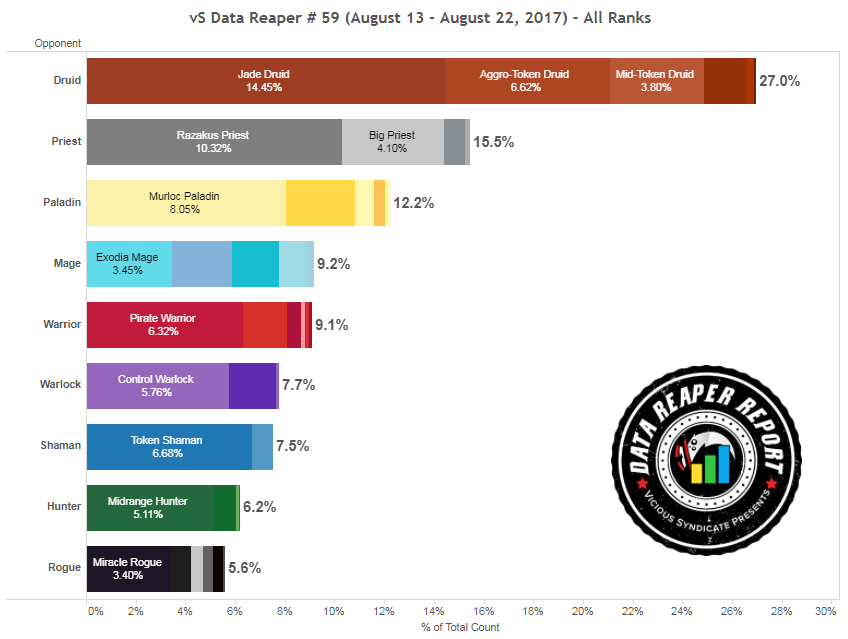
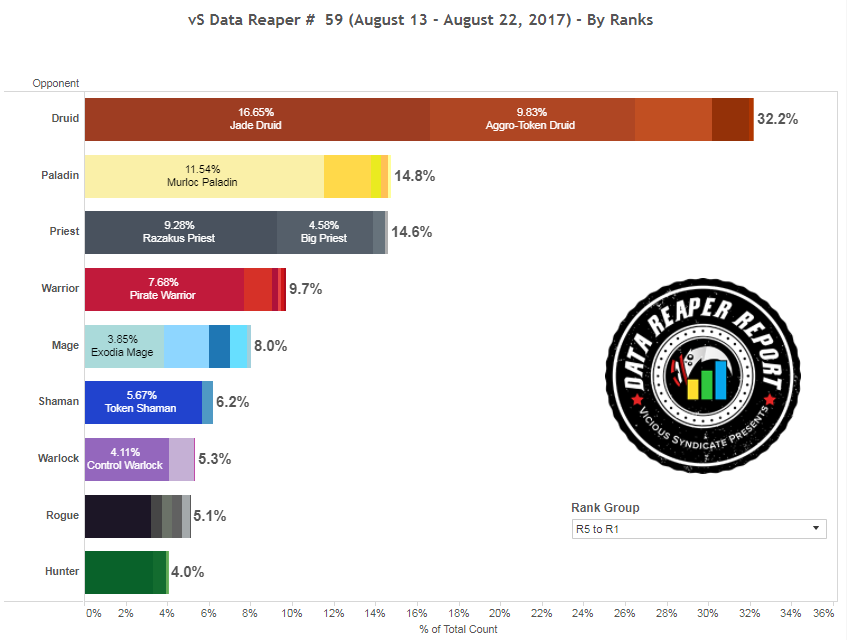
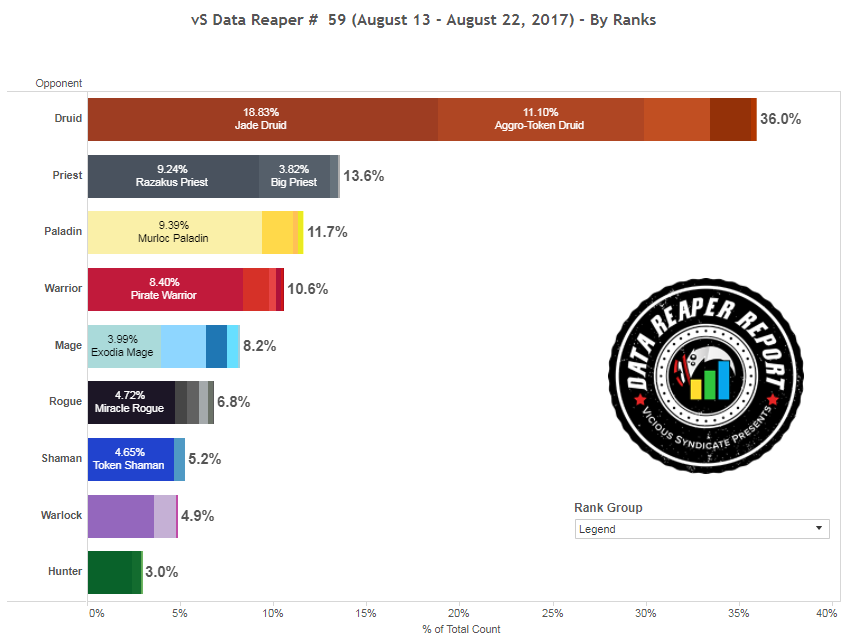
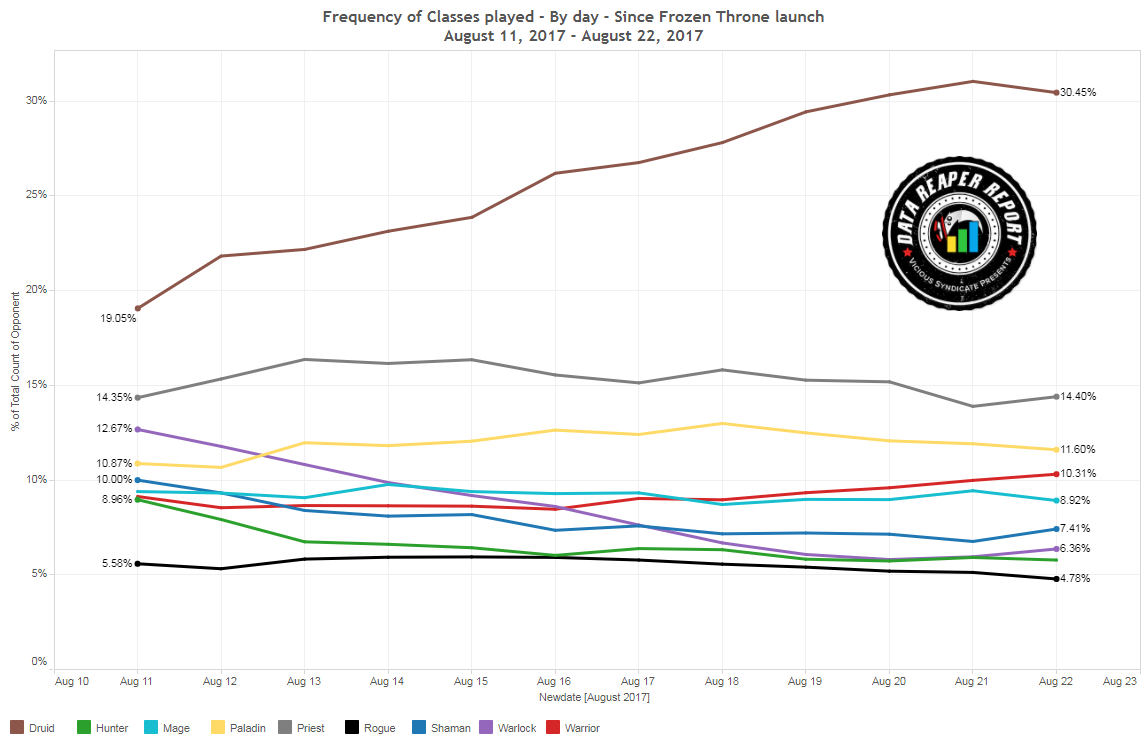
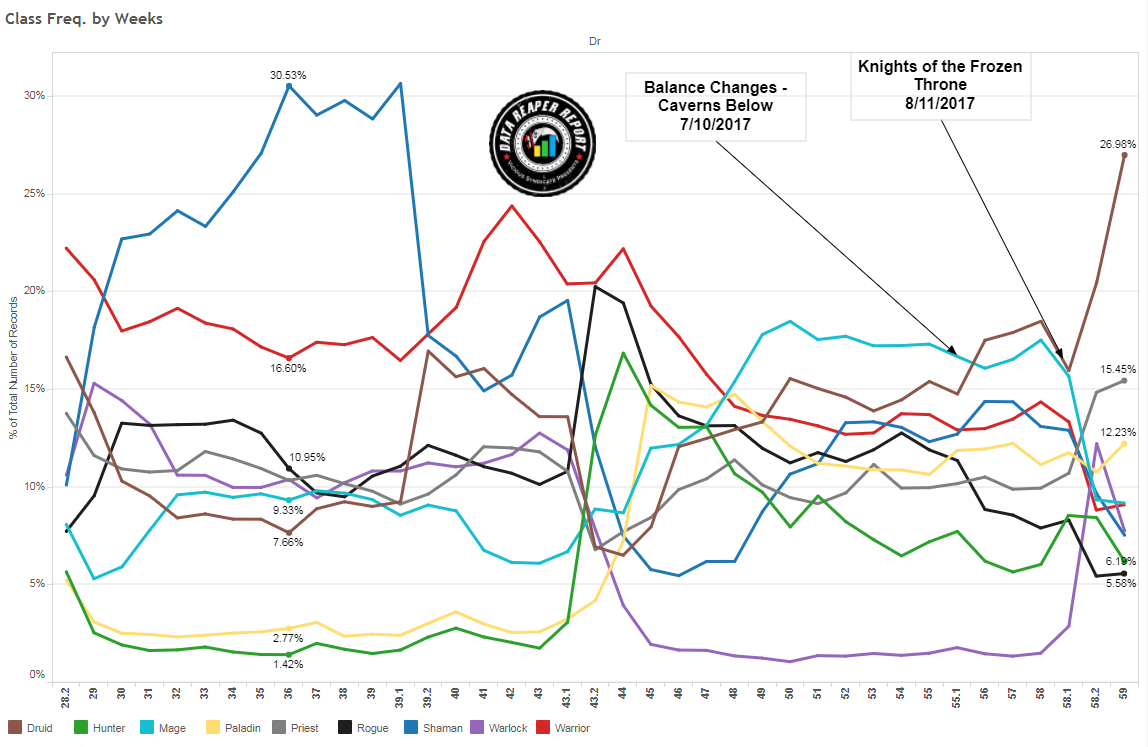

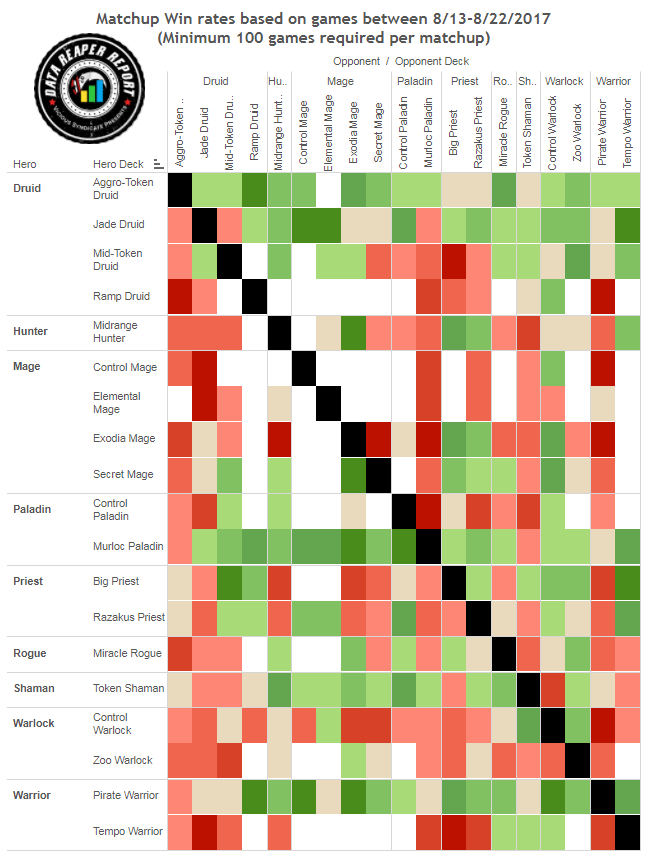
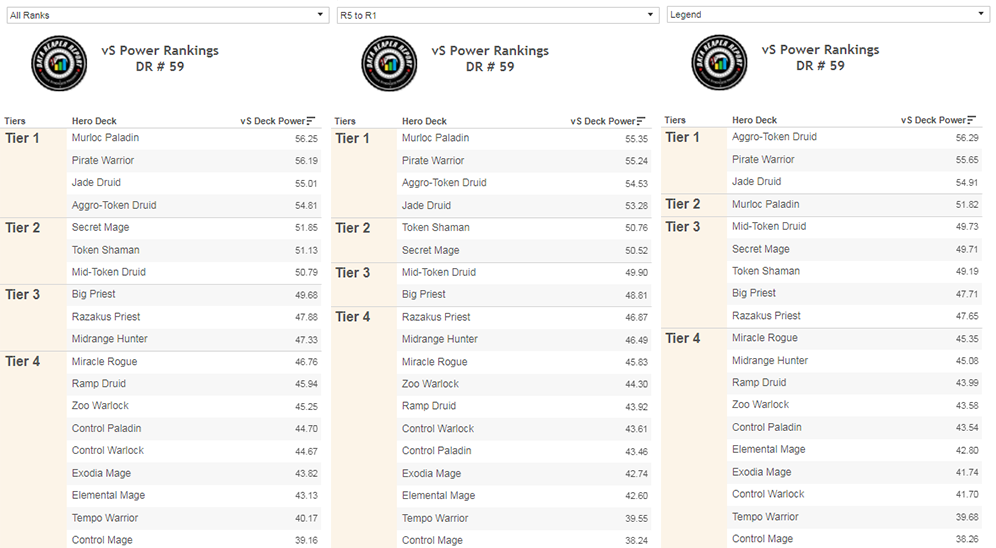
























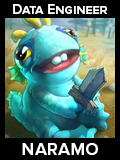

Please congratulate whoever wrote this article, specifically the following paragraph.
Brace yourselves, Hearthstone players. Winter is here. The Un’Goro golden age has ended. The days of 18 viable archetypes from 8 different classes boasting win rates of over 48%, are gone. The period when decks could hardly break the 52% win rate mark at legend, is over. This is the age of the oppressive few. This is the age of Jade Druid, and the aggro decks that don’t roll over and die at the sight of it. There are only 4 archetypes that currently boast a positive win rate at legend, and there is a huge gap in the power level of these archetypes compared to everything else.
The menacing feeling of Malfurion obliterating everyone in his path resonates with this entire article. He is not a generous god. He is not a merciful god. He is death and decay that infects all and is ally to no one. The moment you face him, you know the deck is stacked against you.
Enthusiastic HS players like myself really enjoy reading articles like these because it goes beyond the facts, beyond the stats. It injects a flavor into the article and gives it a theme. And for now, that feeling is impending doom.
Please keep it up, expand the theme even more, and if you ever need a hand on future articles, I’ll be glad to help.
thank you . very helpful .
Besides, we want another Wild Report.
Hi, was wondering why elemental mage is seen in the power rankings but no decklist was provided?
Hello, when the reports were in Russian and I read them with pleasure, now it is difficult, why stopped the translation?
I’m wondering why the Skulking Geist is not included in almost every deck as a tech choice, as it can partially counter Jade Druid decks. Am I missing something?
some decks don’t have the same game plan as decks that do run skulking geist. control decks that would run skulking geist have enough removal and value to beat the non-jade idol generated jades, and need geist to stop druid from going infinite and getting more value than they can deal with. decks like aggro and midrange don’t care as much about limiting druid’s value from jade idol because usually their plan is to beat the druid before they even get to shuffle idols, so geist doesn’t really help them in that matchup and a 6 mana 4/6 is a dead card in other matchups.
Sadly most control decks still lose even after playing geist.
I’ve played ~200 games with Jade Druid and I’d guess less than 5% of those games utilized the infinite shuffle mechanic. Geist accomplishes almost nothing against the deck it’s supposed to hard counter and is a complete brick against fast decks.